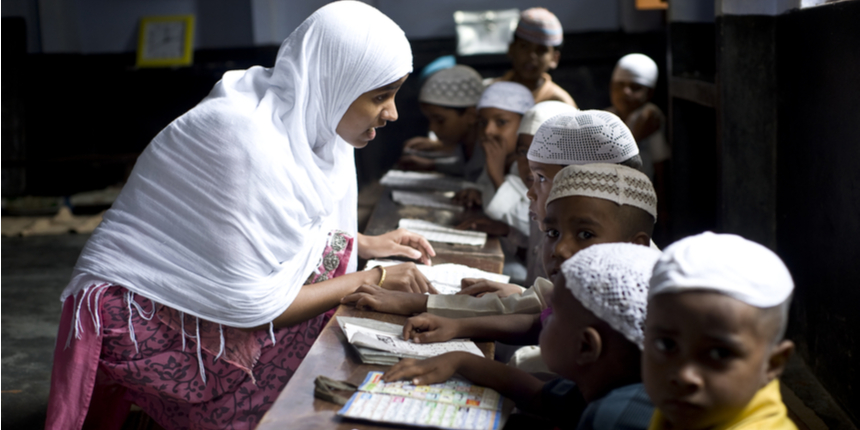Extend RTE to minority institutions, ensure ‘minimum percentage’ of minority students: NCPCR
Atul Krishna | August 10, 2021 | 02:28 PM IST | 3 mins read
Ensure minority schools have a “minimum percentage” of students admitted from Muslim, Christian and other minority communities: Central Child Rights Body

NEW DELHI: The National Commission for Protection of Child Rights (NCPCR), in a report on minority education institutions made public on Tuesday, has recommended that the Right To Education(RTE) Act 2009 be extended to include minority institutions and that states issue guidelines to ensure minority schools have a “minimum percentage” of students admitted from minority communities.
Minority institutions were exempt from the RTE Act. One provision of the RTE Act required schools to reserve 25% of seats to students belonging to economically weaker sections (EWS). Others require schools to have the basic infrastructure and facilities required for quality education. The NCPCR is the top body responsible for overseeing the implementation of the RTE Act in the country. The report says the RTE Act “neither obliterates the minority nature of minority schools nor acts as a hindrance in benefiting the students from the minority community”.
Also Read | Delhi Govt School Admission: Concerns about access, reservation in SoSEs
If the RTE Act cannot be extended to these institutions, the NCPCR recommends framing a separate but similar law for them. The NCPCR has also recommended that states grant minority status to an institution on the basis of the actual representation of the communities among minorities.
Minority Schools: ‘Disproportionate numbers’
The NCPCR report notes that in many states, the number of institutions run by a minority community does not match the community’s representation in the population. “For instance, in West Bengal, 92.47% of the minority population is of Muslims and 2.47% are Christians,” says the report. “On the contrary, there are 114 Christian minority schools and only two schools with Muslim minority status. Similarly, in Uttar Pradesh, though the Christian population is less than 1% there are 197 Christian minority schools in the state.”
“This disproportionate number takes away the core objective of establishing minority educational institutions. Hence, there is a need to link the need of the number of minority institutions in a State for a particular minority to the process of granting minority institution status for better utilization of resources.” it said. The report says that while Christians form 11.54% of the minority population, they run 71.96% of the minority schools. Muslims, meanwhile, form 69.18% of the minority population but run 22.75% of the schools.
| Communities | Percentage of Minority School share | Percentage of Population Share in the schools |
| Christian | 71.96 | 11.54 |
| Muslim | 22.75 | 69.18 |
| Sikh | 1.54 | 9.78 |
| Buddhist | 0.48 | 3.83 |
| Jain | 1.56 | 1.9 |
| Parsi | 0.38 | 0.03 |
| Others | 1.33 | 3.75 |
‘Non-minority students’
The NCPCR report also says that schools were “found to be admitting non-minority students to a large extent” and that minority schools only catered to “less than eight percent of minority students”. The report says that close to three quarters of students in Christian schools are from non-minority communities. “Muslim community schools (20.29%) have the lowest percentages of non-minority population among their minority schools. The Christian community schools have 74.01% of the student population belonging to the non-Christian community. The child rights body reads this as implying the minority institutions are not helping the communities they were set up for.
It recommends that states lay down specific guidelines regarding the “minimum percentage of students from the minority community to be admitted to the institution”. The report also says that “only 8.76% of total students in minority schools belong to socially and economically disadvantaged background[s]”.
Also Read | Over 33% of SC, ST, OBC students drop out in Class 10: UDISE+ Report
It also recommended that the National Council of Educational Research and Training (NCERT) “should play a larger role in taking the fundamental right to elementary education to all children, especially children of minority communities”.
NCPCR said that a large number of students are studying in unrecognised institutions.
It recommended that the children attending all such institutions “are to be treated as out-of-school, even if they provide regular education”.
The report also suggested bringing madrasas under the central government sponsored Samagra Shiksha Abhiyan to enjoy benefits like midday meal, free textbooks, uniforms, teaching-learning material, library, play material, computers, smart classes, and other facilities.
Write to us at news@careers360.com.
Follow us for the latest education news on colleges and universities, admission, courses, exams, research, education policies, study abroad and more..
To get in touch, write to us at news@careers360.com.
Next Story
]Parliamentary panel suggests reopening of schools, measures to reduce learning loss
“Only 23 percent of the students had access to devices to attend online classes so the remaining 77 percent of the students were deprived of attending online classes,” the report said. The increased drop-out rates, as per UDISE report, has increased at the secondary level affecting 17 percent boys and 15.1 percent girls. The data further showed that more than 33 percent of students belonging to Scheduled Castes, Scheduled Tribes and Other Backward Classes drop out of state government schools.
R. Radhika